- Deonna Does AI
- Posts
- I'm a Netflix Engineer Who Vibecoded a Breakup App in 72 Hours By Stalking Reddit — Here's My Exact Playbook
I'm a Netflix Engineer Who Vibecoded a Breakup App in 72 Hours By Stalking Reddit — Here's My Exact Playbook
from idea → research → vibe → build → ship
A confession from a Netflix engineer: After 10 years building software for top Silicon Valley tech companies, I discovered the fastest way to validate product ideas. You direct AI to write code while you focus on understanding human pain.
Last month, I built Haven — a breakup recovery app that helps people through the worst emotional experience of their lives. It went from idea to working app in 72 hours over a few weeks.
Right now, I'm navigating the App Store submission process (Part II coming soon with all those lessons). But the app is built, tested, and ready. Here's exactly how I did it.
What Andrej Karpathy dubbed "vibecoding" is where you become the emotional archaeologist and technical architect while AI becomes your implementation army.
Over 1 million AI-generated websites have been built with Bolt and deployed on Netlify in just five months. Bolt reached $40 million in yearly earnings by March 2025, with about 5 million people signed up to use it.
This playbook shows you exactly how I built Haven — from deep research to working app — with the actual prompts, debugging strategies, and lessons learned along the way.
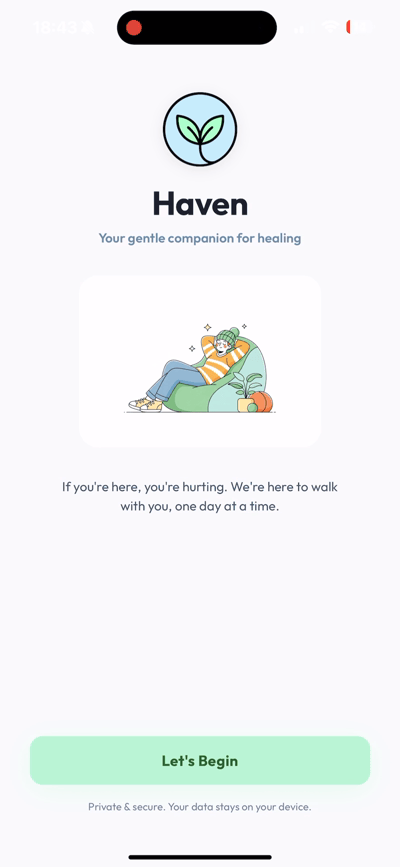
Haven's home after 72 hours of building: simple, focused, and already helping people heal
Part 0: The Deep Research Sprint (The Gold Mine Nobody Talks About)
Before touching any tools, I spent 90 minutes on r/ExNoContact, r/BreakUps, and #healingjourney on TikTok. What I found was a blueprint for exactly what to build.
The best products come from the deepest understanding of pain, especially your own.
Start there. Always.
The Research Prompt That Uncovered Everything
Here's the exact prompt that changed how I think about product research:
SYSTEM:
You are an empathy-driven consumer product strategist specializing in breakup recovery and attachment trauma. Your mission is to explore a market opportunity in the relationship recovery space — especially among users on platforms like Reddit (r/ExNoContact, r/BreakUps), TikTok (#healingjourney, #exnocontact), and YouTube.
This niche is driven by attachment wounds, identity crisis, obsessive rumination, need for control, validation seeking, and hope for reconciliation.
Your job is not to assume what tool to build. First, you must:
🔍 Research what people ACTUALLY feel, crave, and obsess over
🧠 Analyze their emotional & identity struggles
💡 Recommend an initial empathy-first MVP concept
⚙️ Only after this, sketch a buildable MVP
STRUCTURE YOUR OUTPUT:
1. 🩶 Emotional + Identity Drivers
2. 📣 Behavioral Signals from the Field
3. 🧲 Offer Discovery: What Should We Build?
4. ⚒️ MVP Spec: Fastest Path to Delivery
5. 💸 Monetization + Funnel Plan
6. 📈 Virality & Growth Engine
RULES:
- Start with emotional truth, not product fantasy
- Pull real phrases from the field — don't sanitize the pain
- Think "this feels like it was made just for me"
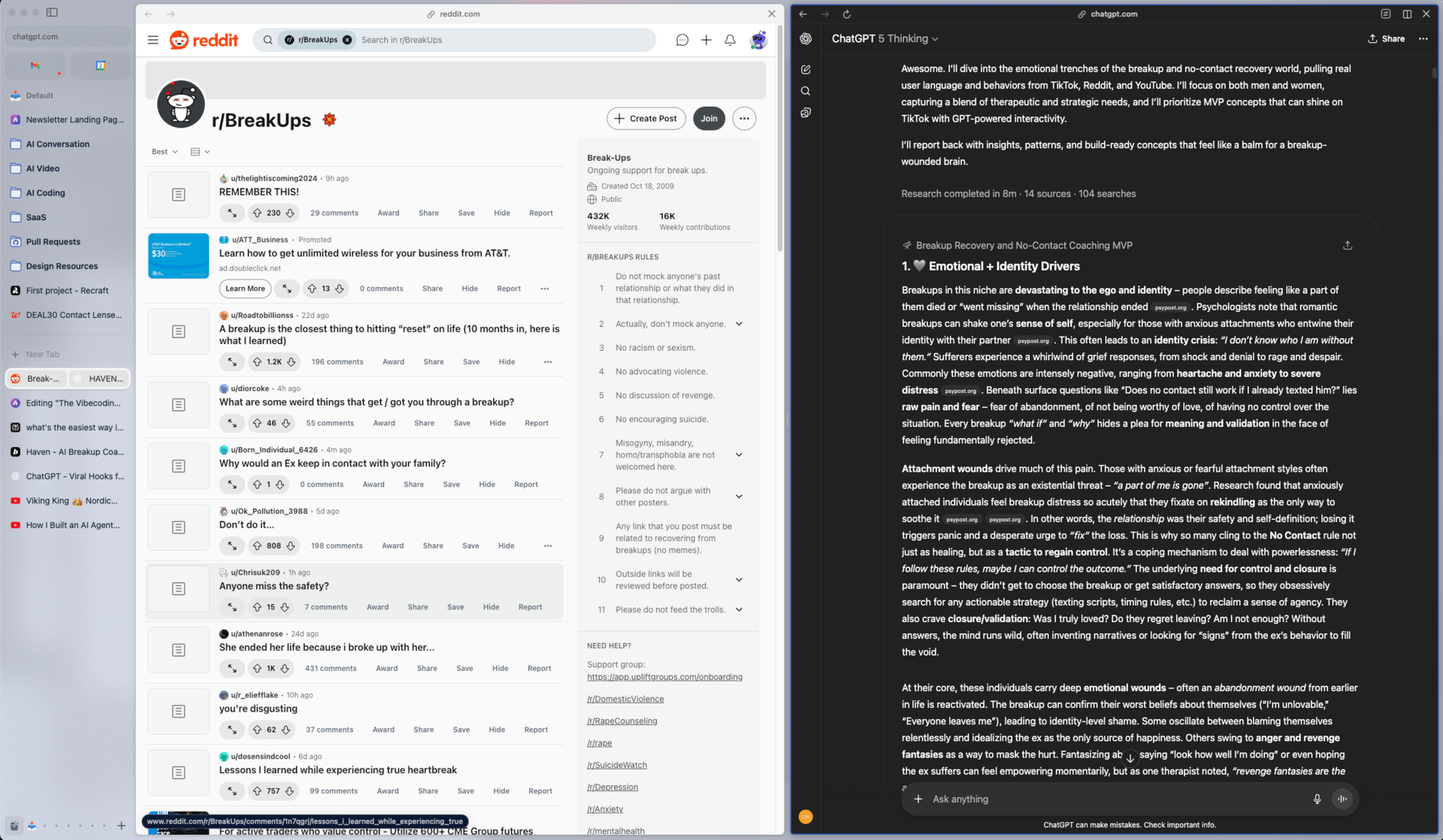
Caption: 90 minutes of Reddit research + AI analysis = complete product roadmap
The Insights That Blew My Mind
Finding #1: Identity Death, Not Just Heartbreak
People weren't saying "I'm sad." They were saying:
"A part of me died when they left"
"I don't know who I am without them"
"I feel like I'm missing a limb"
Psychologists confirmed: for anxiously attached people, breakups literally feel like an existential threat. Their identity was so intertwined with their partner that losing them creates a genuine identity crisis.
Finding #2: The "Hopeium" Addiction
TikTok and YouTube algorithms have learned to feed false hope for engagement:
Videos titled "5 stages your ex goes through during No Contact" with precise timelines
"Week 1: relief, Week 2: curiosity, Week 4: regret"
Creators know hope sells — viewers watch religiously for that dopamine hit
One breakup site exposed it perfectly: "A lot of creators give you that dopamine hit of your ex coming back. They convince you it's only a matter of time. You feel good for a while... then the cycle keeps repeating. The algorithm keeps you hooked."
People were literally addicted to false hope, delaying actual healing.

the "hopeium" economy — millions of views on false certainty
Finding #3: Obsessive Detective Behavior
The specific behaviors I found were wild:
"Day 36 of no contact and he watched my story – does that mean it's working?!"
Analyzing ex's Spotify playlist names for hidden messages
Monitoring WhatsApp "last seen" timestamps obsessively
One person baked a "One Month NC" cake to celebrate
People treat No Contact like a sobriety counter, sharing milestones and seeking congratulations. The community gamifies healing by treating it as a challenge.
Finding #4: DIY Text Analysis Already Happening
This was the jackpot finding:
Users posting screenshots asking "He texted 'happy birthday' after 2 months – is he testing waters or just being polite?"
One Redditor: "I used ChatGPT to analyze our messages for signs of emotional abuse"
Cosmopolitan reviewed "Texts From My Ex" tool where you upload text threads and AI grades your relationship
People were ALREADY using AI for this. They just needed a better, more empathetic version.
Finding #5: Throwing Money at Hope
Despite community warnings about scams, people admitted:
"I paid $500 for a coaching session to try and get my ex back"
"The tarot reader said we're twin flames, so there's hope!"
One user who paid for coaching said: "She accurately predicted my ex's behavior many times"
The willingness to pay was about having someone say "I understand your specific pain and here's what to do."
The MVP That Designed Itself
Based on these insights, Haven's features became obvious:
Ex Text Decoder: Because they're already obsessively analyzing every message
Daily Detox: Because they need structure like a recovery program
No Contact Counter: Because they're already counting days like sobriety
Mood & Urge Tracking: Because they need to see patterns to catch spirals
The research literally wrote the feature list. Your users will tell you exactly what to build if you listen.
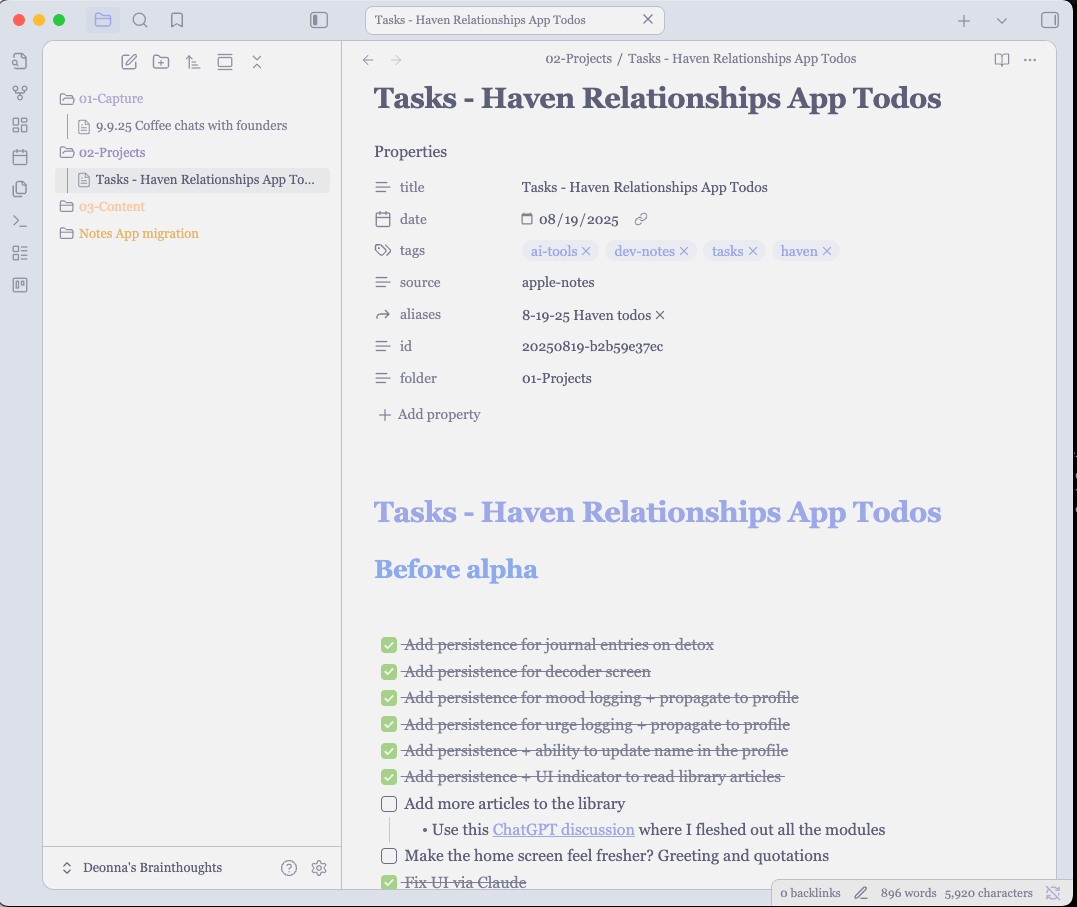
From Reddit posts to feature list—the research made every decision obvious
Part 1: Designing Haven's Vibe (45 Minutes, Zero Design Skills)
I can't draw. But I knew what healing should feel like: soft, safe, hopeful.
Google Whisk is a new generative AI tool that lets you create images by combining other images — not just text. You drag in a subject, scene, and style image, and it creates something new.
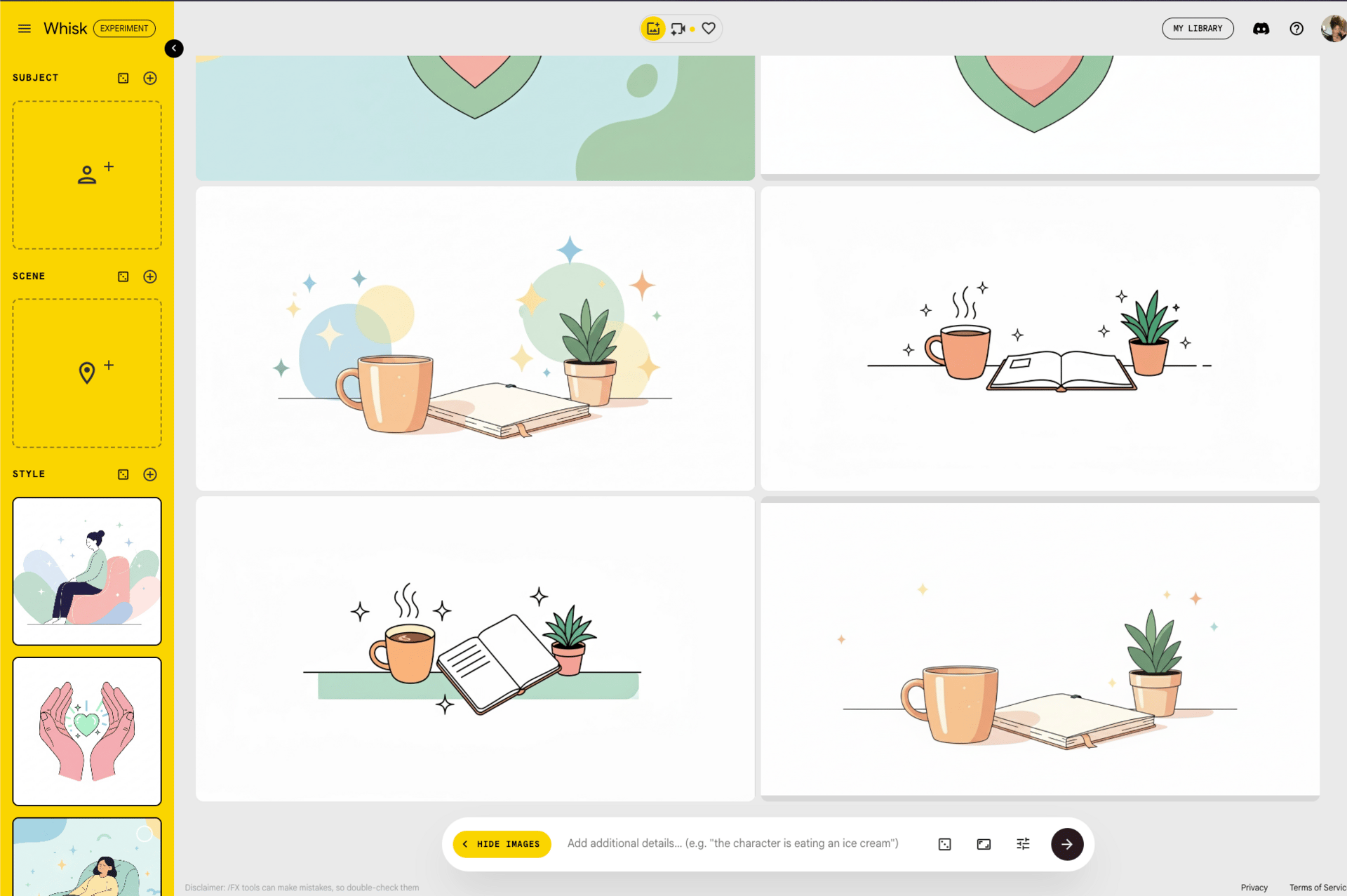
Google Whisk: just drag in a subject, scene and style image. No complex prompting needed.
The Design System That Created Itself
Style Reference: I found one illustration of a woman journaling on a beanbag. Soft, cozy, human. This became the north star for everything.

One image + Google Whisk = entire design system
The Prompts That Built Haven's Visual Language:
Base prompt for everything:
"Flat vector illustration on pure white background. Cozy, human, hopeful.
Rounded lines, soft outlines (2px), minimal detail.
Pastel accents: blush #F8DCE6, lavender #7C6DFF, rose #FF8FB3, mint #9AE6B4.
Style reference: woman on beanbag illustration."
What This Created:
Logo: Sprout in circle (symbolizing protected growth)
Mood Tracker: Thermometer with leafy plant at base (growth through healing)
Onboarding: Hands holding heart, calendar with sprout, books with plants
Empty States: Person on hilltop at sunrise (hope and progress)
Every illustration used the same style reference. Total time: 45 minutes. Cost: $0.
The key insight: Don't try to be a designer. Find ONE image that captures your vibe, then use it as the style reference for everything.
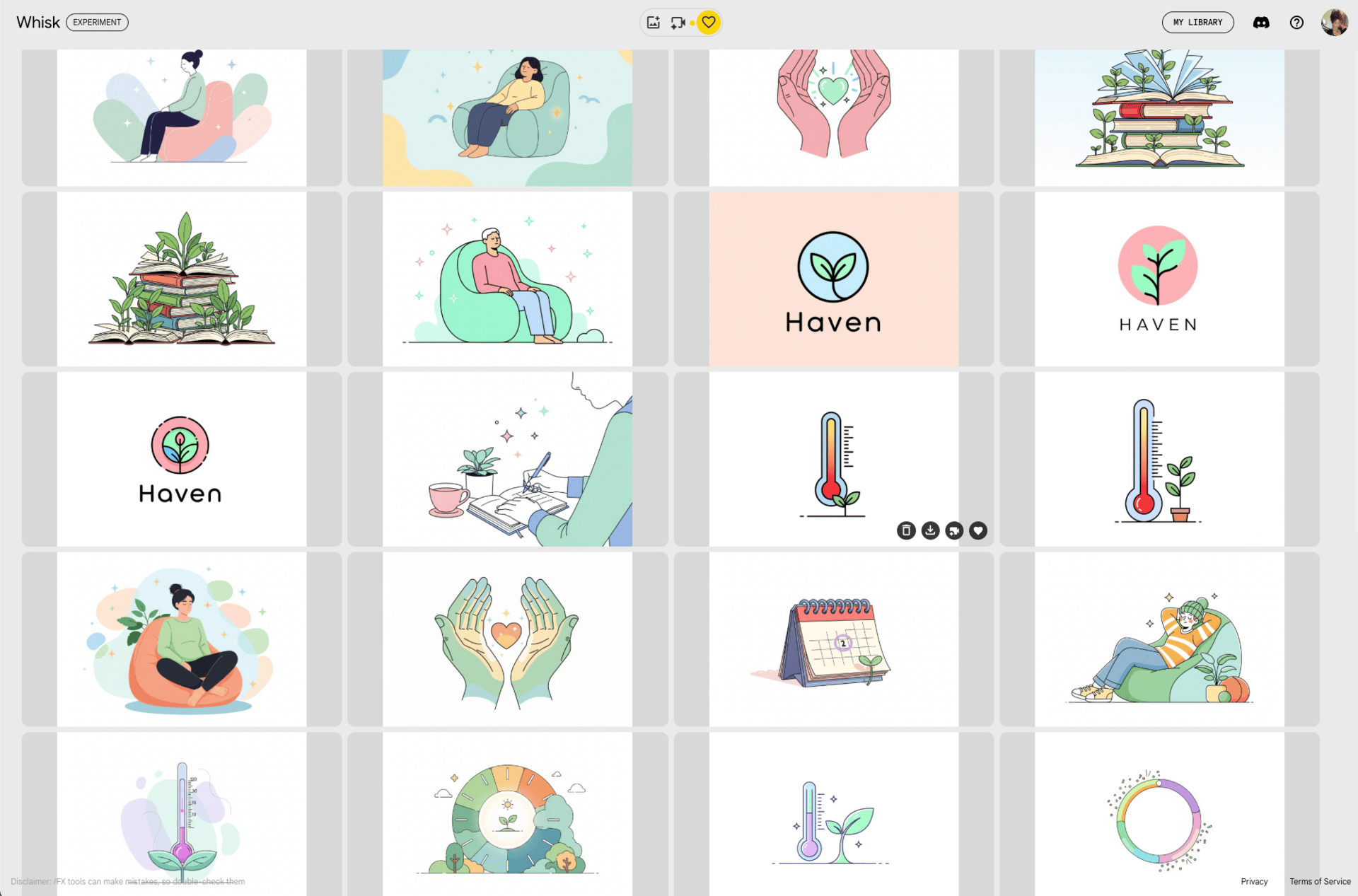
Every illustration from the same style reference — coherent brand in minutes
Part 2: Building Haven with Bolt.new (Where Speed Beats Perfection)
Bolt.new lets you build full-stack apps by describing what you want. But here's the secret: it can't handle huge context. You need micro-prompts that deliver immediate wins.
Every feature you delay is a day someone suffers without your solution. Ship fast, iterate later.
The Master Prompt That Sets Everything Up
SYSTEM:
You are a senior full-stack engineer building Haven, a breakup recovery app.
Work in tiny, shippable units. Optimize for immediate, visible progress.
RULES:
- Work in 10-15 minute chunks
- After each chunk, show: what changed, what works, what's next
- Never introduce more than 1 dependency per chunk
- If error occurs, switch to RECOVERY MODE without asking
CONTEXT:
Stack: React Native/Expo, TypeScript, NativeWind, AsyncStorage
Features: Ex Text Decoder, Daily Detox, mood tracking, local storage
Tone: Empathetic, never clinical, like texting a wise friend
The Micro-Prompts That Actually Shipped
Ex Text Decoder (The Hook Feature):
Prompt 1: Create decoder input screen
Objective: Let users paste their ex's message
Do: Large textarea, "What did they say?" placeholder, Analyze button
Acceptance: Can paste text and tap Analyze
Prompt 2: Wire to OpenAI analysis
Objective: Get actual analysis working
Do: Send to OpenAI with compassionate counselor persona
Return 4 cards: Summary, True Intent, Best Next Move, Sample Replies
Acceptance: Returns helpful, empathetic analysis
Prompt 3: Save decoder results locally
Objective: Let users revisit analyses
Do: Add Save button, store with timestamp and excerpt
Acceptance: Appears in History tab after saving

The Ex Text Decoder in action — turning obsession into insight
Daily Detox (The Retention Feature):
Prompt 1: Rotating journal prompts
Objective: Make journaling feel fresh
Do: Random daily prompts like:
- "What would you tell a friend going through this?"
- "Describe your feelings in weather terms"
- "What's one thing you're grateful for?"
Acceptance: Different prompt each visit
Prompt 2: Stay on screen after save
Objective: Don't interrupt the flow
Do: After save, stay put, show toast "✨ Saved. Small steps beat spirals."
Show "Today's entries" preview below
Acceptance: Can save multiple entries without leaving

Journal, reflect and breathe.
The "You" Profile (Personalization Without Friction):
Prompt 1: Default name is "You"
Objective: Work without forcing signup
Do: Profile shows "You" by default, editable inline
Acceptance: Works immediately, can personalize later
Prompt 2: Use name everywhere
Objective: Make it feel personal
Do: Headers show "Hi, You" or "Hi, [Name]" throughout
Acceptance: Feels like the app knows them
The Local-First Architecture (Privacy as a Feature)
Instead of building auth and cloud storage, I made everything local:
Prompt: Create durable local storage
Objective: Never lose user data
Do: AsyncStorage buckets for profile, journals, decodes, moods, urges
Schema-agnostic: {id, createdAt, payload}
Footer everywhere: "Stored on this device"
Acceptance: Data survives app updates, user trusts privacy
This wasn't just faster — it became a selling point. In a world of data breaches, "your heartbreak stays on your phone" built massive trust.
Part 3: The Error Recovery Reality (What Actually Happens at 2am)
Things broke constantly. The difference between shipping and quitting was having a system for getting unstuck.
Every bug you fix makes you stronger. Every error teaches you something. Keep going.
The Step-Back Recovery Protocol
When Bolt gets stuck fixing the same error 5+ times, you need to break the loop:
🚨 [Error Recovery Task] 🚨
You encountered a recurring error not resolved despite multiple attempts:
ERROR CONTEXT: [paste error and what you tried]
#TASK
1. DO NOT attempt to fix immediately
2. Perform Step-Back Reasoning:
- What assumptions are being made?
- What conditions must be true for this to fail?
- Are there lifecycle/timing issues?
3. Walk through 2+ possible root causes
4. Suggest a fix that:
- Is NOT a repeat of previous attempts
- Includes validation steps
- Has rollback instructions
#CONSTRAINTS
- Avoid repeating failed fixes
- Provide specific debugging steps
- If uncertain, ask clarifying questions
Real Crisis: The Decoder API Meltdown
Hour 1-3: Standard attempts (all failed)
Added retry logic → didn't help
Added error handling → just showed errors faster
Increased timeout → made it worse
Hour 4: Applied Step-Back Protocol
Root Cause Analysis:
1. No rate limiting on client = firing too fast
2. No queue for failed requests = losing user data
3. Multiple instances might be running
Validation: Log timestamps between requests
Fix: Exponential backoff + persistent queue + user-facing status
This finally worked. The key was forcing Bolt to analyze WHY, not just HOW to fix it.
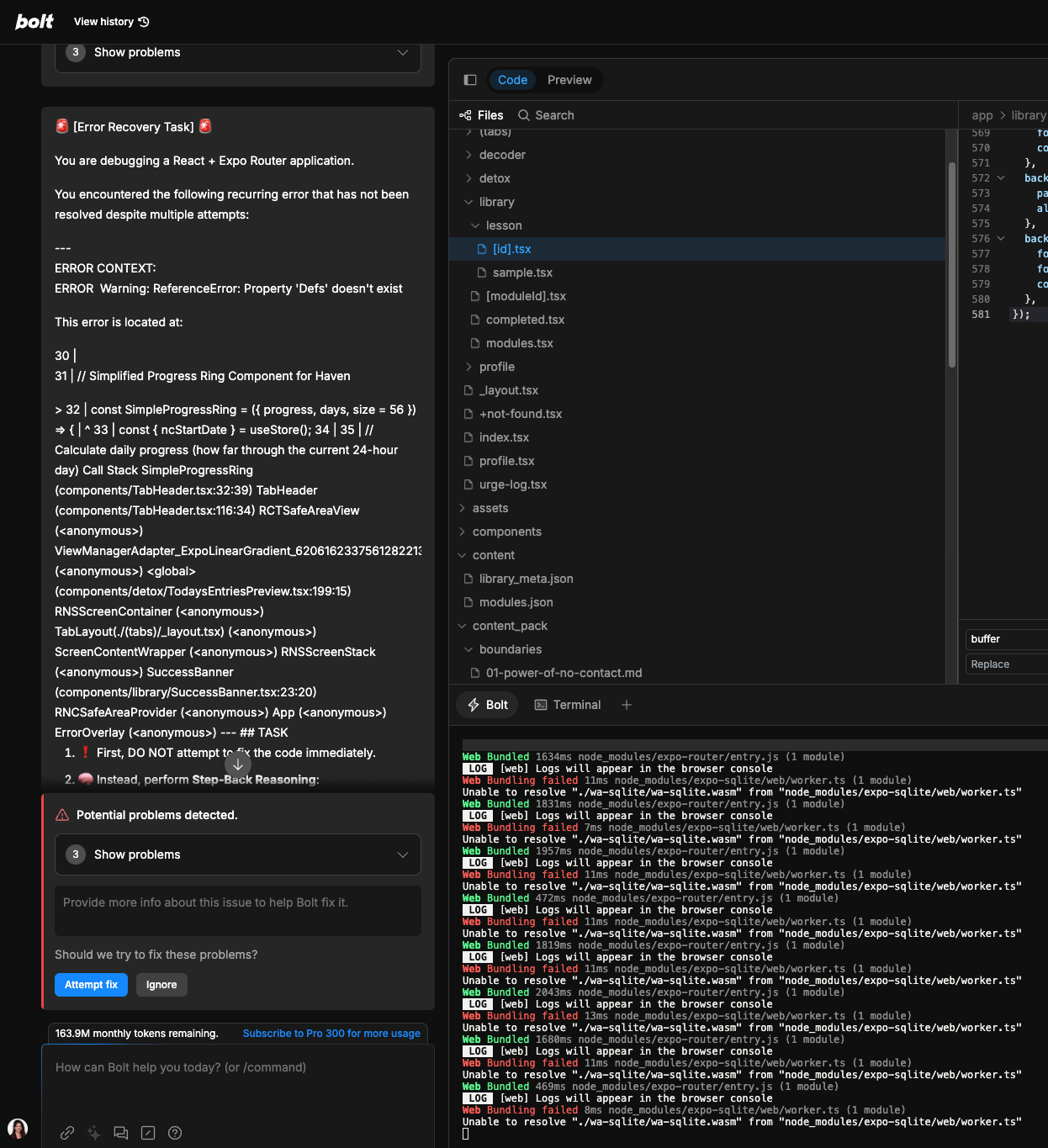
The 2am debugging session that almost broke me, but taught me everything
The Emergency Protocols That Saved Haven
The Nuclear Option:
"List every file changed in last hour.
Create backup branch. Revert to last working state.
Re-apply changes one at a time until it breaks."
The Dependency Detective:
"Check package.json for recent additions.
Remove them one by one. Test after each.
When error disappears, we found the culprit."
The Context Reset:
"You seem stuck. Let's reset. Tell me:
1. What we're building
2. What works
3. What's broken
4. What didn't work
Now suggest completely different approach."
Part 4: The 72-Hour Sprint Timeline
Day 1: Research + Core (12 hours)
9-11am: Deep research on Reddit/TikTok
11am-1pm: Set up Bolt project, basic navigation
2-6pm: Ex Text Decoder working end-to-end
7-10pm: Daily Detox with rotating prompts
10pm-12am: Debug decoder rate limiting (first crisis)
Day 2: Polish + Storage (14 hours)
8-10am: Local storage architecture
10am-2pm: Archives with tabs
2-4pm: Profile with editable name
4-7pm: Mood & urge tracking
7-9pm: Debug storage corruption
9pm-1am: Onboarding flow with illustrations
Day 3: Ship Prep (10 hours)
9-11am: Fix critical bugs
11am-1pm: Wire all illustrations
2-4pm: Record demo video
4-6pm: Create landing page
6-7pm: Submit to TestFlight
Total: 36 hours of actual building across 72 hours. If you have a day job like I do, break it up into chunks.
You have everything you need to start. The only thing between you and shipping is starting.
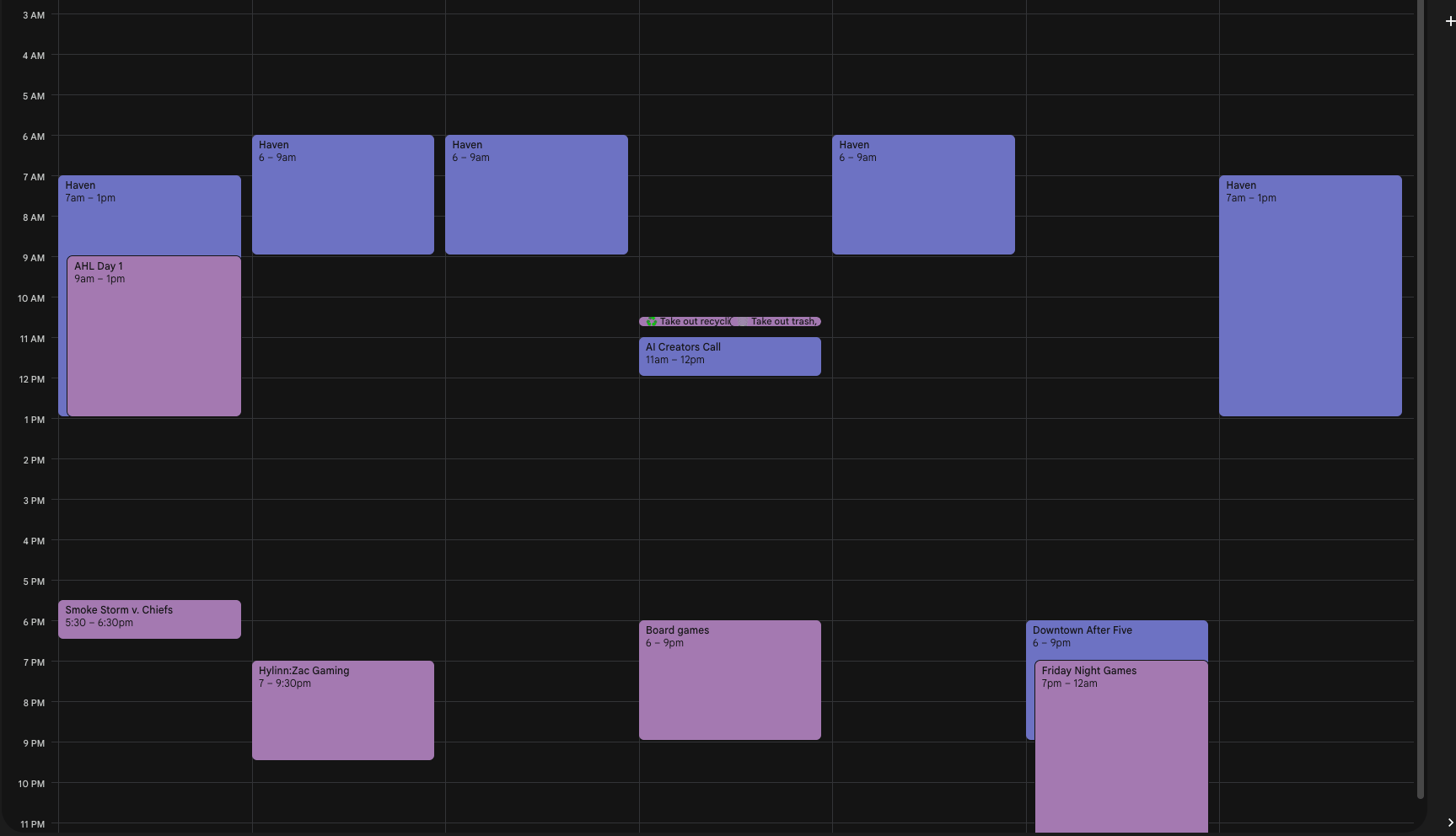
72 hours from idea to TestFlight. You can do this too.
Current Status: The App Store Journey Begins
Haven is built, tested, and in TestFlight with beta users who love it. Part II of this series will cover:
Privacy policy requirements for AI-powered apps
Apple's review process for mental health apps
Screenshot optimization for breakup-related keywords
TestFlight feedback that changed everything
Pricing validation ($29.99/year is too cheap according to users!)
The Meta Lessons from Building Haven
What The Research Revealed About Product Building
Lesson 1: Pain Has Patterns Every emotional pain point has observable behaviors. Don't guess what people need. Watch what they already do to cope. Haven users were already counting days, analyzing texts, seeking validation. I just gave them better tools for what they were already doing.
Lesson 2: Communities Are Your Co-Designers That 90 minutes on Reddit gave me:
Exact feature requirements
Marketing copy (their actual words)
Pricing signals ($500 for coaching = $30 for app is nothing)
Distribution strategy (where they already share progress)
Lesson 3: Speed Beats Perfection Haven's TestFlight users don't care that it was built in 72 hours. They care that it understands them.
Lesson 4: Constraints Create Creativity Local-only storage was a constraint (faster than building auth + a database schema). It became a feature (privacy). The 72-hour deadline forced focus on what actually mattered: the Ex Text Decoder hook and Daily Detox retention loop.
Your perfect app shipped beats someone else's perfect idea every time.
Your Haven-Style Action Plan
Stop consuming. Start creating. The world needs what you're about to build.
Week 1: Deep Research Sprint
Day 1-2: Pick an emotional pain point
Find the subreddit where they gather
Read 100 posts, note exact phrases
Look for what they're already trying
Day 3: Run the research prompt
Use the exact framework I provided
Let GPT analyze patterns you might miss
Identify the "Ex Text Decoder" of your space
Week 2: Build Your MVP
Monday: Design sprint with Whisk
Find ONE image that captures the vibe
Generate 5-8 illustrations using it as style reference
Create logo and core visuals
Tuesday-Wednesday: Build hook feature
Start with the feature that addresses the most acute pain
Use micro-prompts, ship in chunks
Get it working, not perfect
Thursday: Add persistence
Local-first with simple schema
Make data survive restarts
Add "stored on device" for trust
Use Supabase if you need a more robust solution
Friday: Polish and connect
Wire illustrations to screens
Add onboarding flow
Fix only critical bugs
Week 3: Test and Iterate
TestFlight with 20-50 target users
Watch what features they use first
Collect feedback and double down on what resonates
The clock is ticking. Someone needs what you're about to build. Start now.
The Resources That Matter
Research Tools:
Similar subreddits for your niche (find where your audience gathers)
TikTok and Instagram (search emotional hashtags)
Google Whisk (image generation via style reference)
Bolt.new (the builder that understands context)
Communities for Support:
r/SideProject (show your progress)
Bolt Discord (24/7 debugging help)
Twitter #buildinpublic (accountability)
Documentation to Bookmark:
Expo Router docs (navigation patterns)
AsyncStorage guide (local persistence)
OpenAI API docs (understand rate limits!)
Apple App Store Guidelines (Section 1.4.2 for health apps)
The Truth Nobody Tells You
Building products requires understanding humans more than understanding code.
I spent 10 years building software at top tech companies. But Haven taught me that understanding why someone checks their ex's Instagram 47 times at 2am matters more than understanding database sharding.
The future belongs to engineers who can combine emotional intelligence with technical leverage. AI handles the implementation. You handle the empathy.
Your users don't care if you hand-coded every line or directed AI to write it. They care that someone finally built something that understands their specific flavor of pain.
You already have everything you need: empathy, curiosity, and access to the same tools I used. The only difference between thinking about it and shipping it is starting.
Now go find an emotional pain point. Spend 90 minutes understanding it deeply. Then build something that helps.
The world needs more engineers building with empathy, not just efficiency.
Your app could change someone's life. But only if you build it. Start today.
-Deonna
P.S. Haven's TestFlight users are already asking when it hits the App Store. Part II will cover that journey. If you're building something for people in pain — physical, emotional, or spiritual — email me at [email protected]. The world needs more of us building tools for healing.
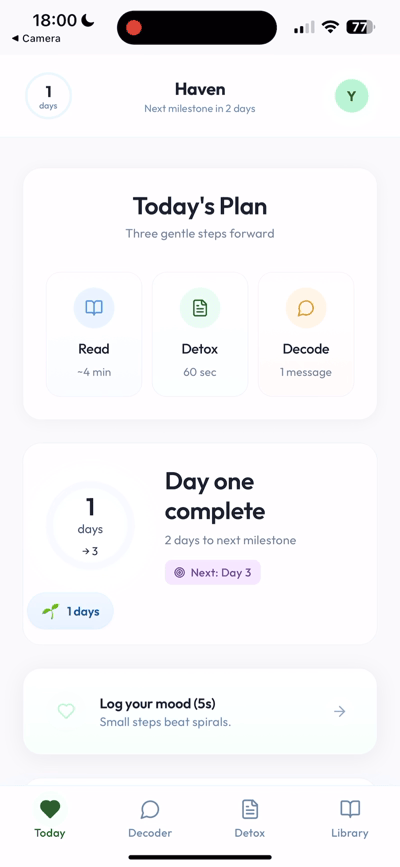
From idea to impact in 72 hours. Your turn to build something that matters. 🥰